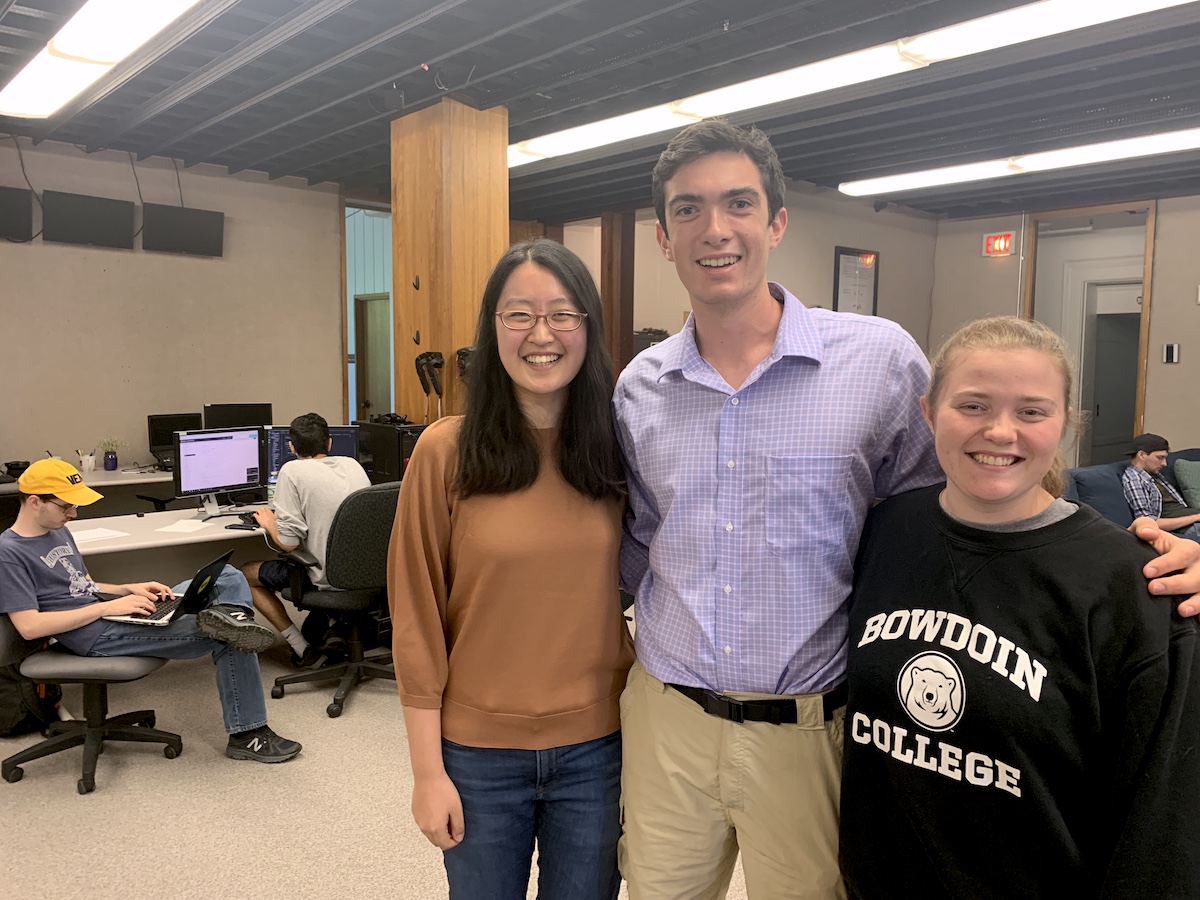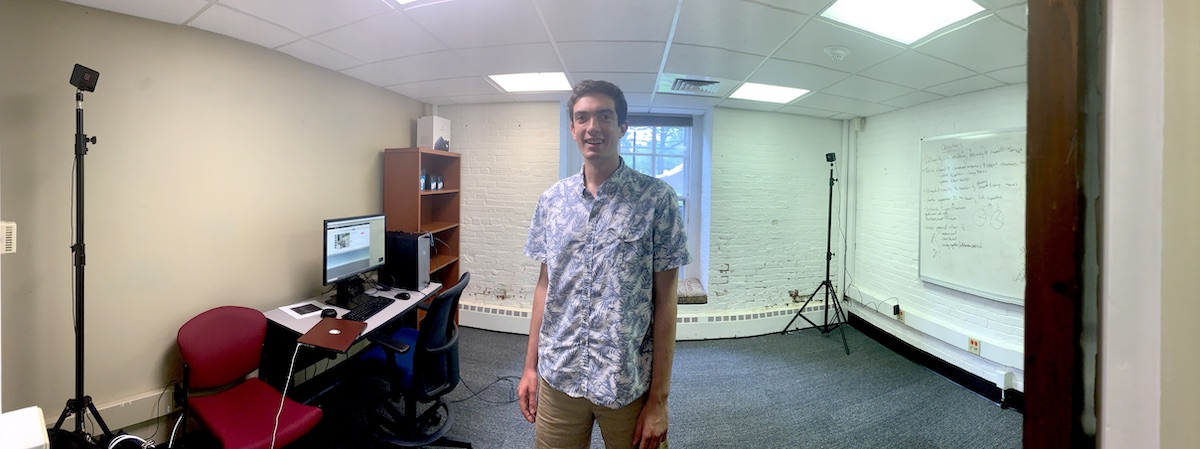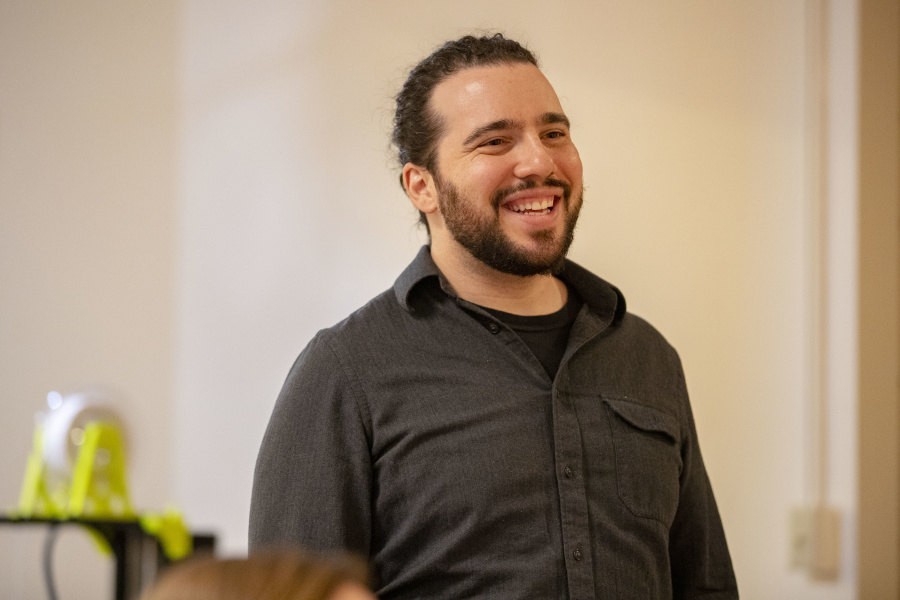Virtual Reality Opens Up New Worlds at Bowdoin
By Rebecca GoldfineVirtual reality is dreamy, thrilling, weird, and exciting, and its potential for research, teaching, making art, and programming is capturing the curiosity and imaginations of faculty, students, and staff at Bowdoin. One professor has already incorporated virtual reality into his anthropology class. A computer science professor is making advances in the field. Several students this summer are programming new virtual reality environments.
And IT and library staff at Bowdoin are making it all possible, especially Stephen Houser, Paul Benham, and Carmen Greenlee. Responding to rising interest, Bowdoin will open a new virtual reality lab on campus this fall in the basement of Hubbard Hall.
Bowdoin Students in VR



Matthew Donnelly ’22 is one of several students this summer who has a Bowdoin fellowship to tackle a virtual reality project. With funding from a Gibbons grant, he is soaking up as much information as possible at the University of Maine's successful, ten-year-old VEMI virtual reality lab in Orono, which makes virtual testing environments for researchers working in range of areas, from architecture to climate change. With his new expertise, he'll help set up Bowdoin's lab in August.
"A big focus for me has been getting comfortable with virtual reality software," Donnelly said, so that he can create and tweak virtual reality environments, often called "demos," for Bowdoin faculty members who want to use them in their classes or for research.
Laura Friel ’22 and Dani Hove ’20 also have Bowdoin grants to pursue virtual reality projects this summer. Friel, like Donnelly, is spending a lot of time this summer at VEMI, where she has a Computer Science Student Fellowship to help Emily Blackwood, a PhD student, recreate a Peruvian archaeology site. One of their goals is to enable users to experience the 6,000-year-old site from the point of view of its former inhabitants.
Hove, a computer science and math major who is a big fan of virtual reality ("I think it's incredible; I absolutely adore it," he said), has a Surdna Foundation Undergraduate Research Fellowship to figure out how to make virtual reality environments more comfortable for users. Sometimes in a virtual environment people will develop motion sickness, especially when their surroundings are moving while their body, stuck back in ordinary reality, remains still. "At minimum, it can be uncomfortable," Hove said. "At maximum, it can cause horrific nausea and vomiting."
To ease people into a new virtual environment without sickening side effects, Hove is experimenting with altering users' visual fields to give the brain enough cues about the environment's falseness that "their body doesn't have a screaming reaction, like, "what's happening!?" as Hove put it, while maintaining much of the immersive, realistic quality.
Extending Bowdoin's Reality
Stacy Doore, a visiting assistant professor of computer science at Bowdoin, connected Donnelly, Friel, and Rose Xi ’22 to VEMI this summer. (While Donnelly and Friel are working directly with virtual reality, Xi is working on a natural language processing problem: she's tailoring computers' translation of English into wording that describes scientific images and graphs more precisely and clearly for blind or visually impaired people.) Doore completed her postdoctoral research at VEMI and worked as its research manager, so she's familiar with the role a virtual reality lab can play at a research institution.
"Virtual reality is an amazing tool for researchers because, with virtual reality, you can manipulate anything in your environment," Doore said. From psychology and bioengineering research to history pedagogy and language learning, she sees infinite possibilities for the technology at Bowdoin.
In her own work, Doore is exploring how virtual reality can help design better indoor navigation systems for people with visual impairments, to help familiarize them with an indoor environment before they visit it—say, before they have to navigate the melee of a chaotic airport. "You can run spatial cognition experiments in virtual reality over and over in a safe environment, adding new elements and complexities," she said. Working in virtual test environments, with both sighted participants and participants who have visual impairments, helps her to narrow down the most effective natural-language navigation and scene description cues.
The Bowdoin lab will have both software and hardware for virtual reality, augmented reality, and 360-degree video (all together, they're often referred to as extended or mixed reality). "They're all distinct," said Bowdoin Humanities and Media Librarian Carmen Greenlee, who consults with faculty interested in using any of these technologies in their classes. [To read more about what academics are saying about virtual reality in the classroom, check out this article in The Chronicle of Higher Education.]
Some see biology classes as a natural fit for virtual reality. Students studying anatomy can travel through human arteries or move around inside a brain or lung. Donnelly, who is interested in majoring in both biology and computer science, has tried out some of Bowdoin's medical programs for virtual technology. "You can see all the alveoli, it is so memorable," he said. "I can picture it in my head right now, what it's like to be inside a lung. It's way better than looking at a diagram."
Last semester, Assistant Professor of Anthropology Willi Lempert had his students watch (or rather, experience) extended reality films in his Global Indigenous Cinema class. Some of these works were inspired by the indigenous futurism movement, a concept first proposed by scholar Grace Dillon. "One idea she talks about is that, for a lot of indigenous people, the apocalypse has already happened, and they live in a postapocalyptic world," Lempert said. In Biidaaban: First Light, viewers walk through what at first appears to be a bleak urban dystopia—while hearing a bird's song and, at one point, observing a person planting a sapling near pavement.

"Viewers come to realize throughout that it is far from dystopian," Lempert said. "It's about Indigenous futures and suggests nature coming back into balance with an urban area."
The class also spent time discussing how extended reality might be considered "empathy machines," because you can almost literally walk in someone else's shoes—perhaps as they receive food rations in a refugee camp, flee a bombed building in a far-off civil war, or try to cross a sea on a raft.
One of the films Lempert uses in his class Thalu: Dreamtime Is Now has users inhabit the body of a mine worker as he is guided by an indigneous spirit guide in Australia. "We talked about the ethical and moral problems with the program," Lempert said. "If this technology becomes mainstream, and you can experience other people's experiences," does it encourage empathy and compassion? Or does it just devolve into escapist entertainment, something like "identity tourism?" he asked.
With the introduction of each newfangled technology into our society, ethical questions are raised. And these are the types of questions liberal arts colleges are particularly well suited to grapple with, especially as virtual reality technology improves and becomes more "real."